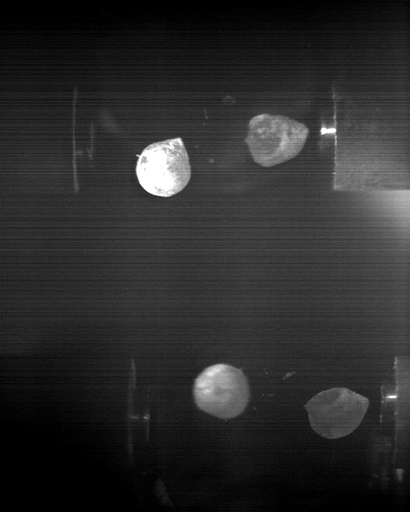4 Forming planets: an introduction
Earlier this week you looked at drop towers on Earth. And in Section 1 of Week 1, you looked at parabolic flights in the ‘vomit comet’.
It might surprise you to know that microgravity environments can also be used to model the formation of planets.
Knowing this and based on what you have learned previously you should now complete Activity 4.
Activity 4 How planets are formed
Choose one answer for each of the following questions.
When it comes to forming planets, our best guess is that smaller particles collide with each other. They then stick together and grow bigger and bigger.
Watch Video 4, a high-speed, high-resolution video, which shows some icy particles in a microgravity parabolic flight experiment. They are only a few millimetres in diameter and collide at low velocities. Then complete Activity 5.

Activity 5 Observing icy particles in microgravity
Choose the correct options to complete the following statements.
Answer
Don’t forget that we have also got a mirror showing the same event from a different angle
a.
They collide and merge on one occasion.
b.
They collide and bounce off each other.
c.
They completely miss each other.
d.
Nothing.
e.
They collide and merge on all of the occasions.
The correct answer is b.
Video 4 shows that even small particles of a very small size (cm to mm) at low velocities don’t easily stick together. This video became the subject of an OU paper published in 2014 called ‘Collisions of small ice particles under microgravity conditions’ (Hill, Heißelmann et al., 2014 [Tip: hold Ctrl and click a link to open it in a new tab. (Hide tip)] ).
The following text is a summary of this paper. After you have read it, complete Activity 6.
Planetesimals are thought to be formed from the solid material of a protoplanetary disk by a process of dust aggregation. It is not known how growth proceeds to kilometre sizes, but it has been proposed that water ice beyond the snowline might affect this process. To better understand collisional processes in protoplanetary discs leading to planet formation, the individual low-velocity collisions of small ice particles were investigated. The particles were collided under microgravity conditions on a parabolic flight campaign using a purpose-built, cryogenically cooled experimental set-up. The set-up was capable of colliding pairs of small ice particles (between 4.7 and 10.8 mm in diameter) together at relative collision velocities of between 0.27 m/s and 0.51 m/s at temperatures between 131 K and 160 K. Two types of ice particle were used: ice spheres and irregularly shaped ice fragments.
Bouncing was observed in the majority of cases with a few cases of fragmentation. Coefficients of restitution were evenly spread between 0.08 and 0.65 with an average value of 0.36, leading to a minimum of 58% of translational energy being lost in the collision. The range of coefficients of restitution is attributed to the surface roughness of the particles used in the study. Analysis of particle rotation shows that up to 17% of the energy of the particles before the collision was converted into rotational energy. Temperature did not affect the coefficients of restitution over the range studied.
Activity 6 Collisions of small ice particles in microgravity
Based on the summary of the paper on the ‘Collisions of small ice particles under microgravity conditions’, complete the following statements.
Next, you will look at how models can be used to change parameters (or variables) in conjunction with experimental data.
